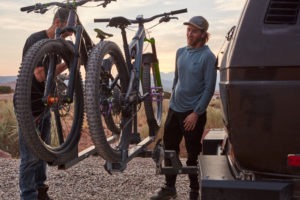When you’re in the mood to go mountain biking, it’s easy to simply throw on your favorite shirt and shorts, slip on a decent pair of shoes, and pedal your way into your next adventure! But you’ll want to dress in mountain biking specific clothing to successfully avoid unnecessary bumps and scrapes, prevent overheating or getting too cold on your bike, or ending up with blisters and otherwise.
The world of biking has a fiercely loyal following, from commuters, avid exercise fans, adventurers, and otherwise. Each niche of biking will require a different type of bike, tires, and gear, so it makes sense that it would also require it’s own unique clothing to have the best time on your mountain bike!
In this feature, we will be tackling some of the things you should always consider when shopping for your next pieces of mountain bike clothing and protection whether you’re just starting out or you’re uncomfortable on your outings, looking for what to wear mountain biking.
Layering for Mountain Biking
Starting out our list of what to wear mountain biking is layers. Generally, riders go out mountain biking in warm weather. Because of this, your standard cycling jerseys should do the trick to start.
These articles of bike specific clothing are made with materials best suited for the intense activity of mountain biking. These may come in a variety of options, such as short sleeves and long sleeves. Short-sleeved jerseys are perfect for hot summer days when you don’t want to overheat when pedaling. However, long-sleeved jerseys are a great option when you’re looking to avoid sunburn and want an added layer of protection.
Cycling jerseys are made of materials and fibers that help wick away sweat. It’s a good idea to invest in a jersey that has a fair amount of mesh panels for breathability when you’re considering what to wear mountain biking in warm weather.
If you’re going out mountain biking in colder weather, you may want to start with a base layer and or jersey and add or bring a cycling jacket or vest with you on the mountain biking trails.
Biking Shorts or Pants
Next on our list of what to wear mountain biking is shorts or pants. Biking or cycling shorts and pants can vary depending on what you need when riding. Padded shortsprovide comfort on your bike seat. These are recommended for bikers of all levels.
Waterproof cycling shorts are also a great option, especially if you find yourself loyal enough to the sport that you’re biking in less-than-ideal weather conditions. There are also options that have tons of extra padding, and they are perfect for longer-trail rides. For those of you in colder environments, cycling pants are a better option to ensure you stay warm and protected from the chilly air.
Proper Footwear
Last on our list of what to wear mountain biking is shoes. A good pair of cycling shoes can mean the difference between a successful bike ride and one that ends up being a complete uncomfortable and literal flop (off your bike)! You’re going to want to go for a pair of shoes that grips well on your pedals, whether you prefer clipless or flats, and offers a comfortable fit.
Consider how breathable they are for warm weather or how much warmth they provide for cold weather as well. Additionally, investing in a few nice pairs of cycling socks. It can help regulate moisture on your feet in all conditions, keeping you comfortable in the heat, while other designs will you keep you warm in colder weather.
Mountain Biking Gear
Aside from the overall attire, protective gear is crucial to your cycling experience and something you should always wear mountain biking.
Starting off our roundup is a bike helmet. This is arguably the single most important protective gear for any extreme sport. Helmets are responsible for protecting your head from any serious injuries whenever you fall, tumble, or crash. It’s important that you find the perfect fit for you, as a helmet that’s too big or too small won’t properly serve its purpose.
Another thing you might want to wear mountain biking is bike gloves. Gloves are highly recommended for beginners and experts alike, as they help the rider have an even better feel or grip on their handlebars. They can also help reduce stress on the rider’s hands and arms. Having the right size and material for the weather you’re riding in is key to making the most out of your gloves.
Some cyclists also use bike goggles which provide protection from wind, debris, and dust when conquering the trails.
Rounding up our protective gear list are knee, shin, and elbow pads. These are responsible for protecting your body from unwanted bruises and injuries. If you’re just starting out mountain biking, it’s best to invest in a set of good quality pads.
Mountain biking is meant to be fun! If you’re dedicated to the sport, consider these mountain biking parts and upgrades to improve your equipment. The sport is even more fun if you know what to wear mountain biking so that you can stay comfortable and protected while you’re on the trails. Ride safe!








